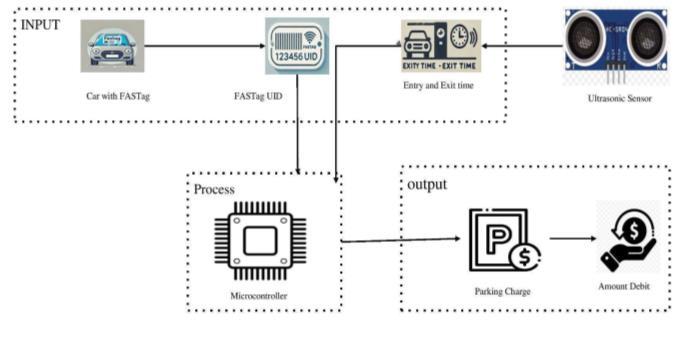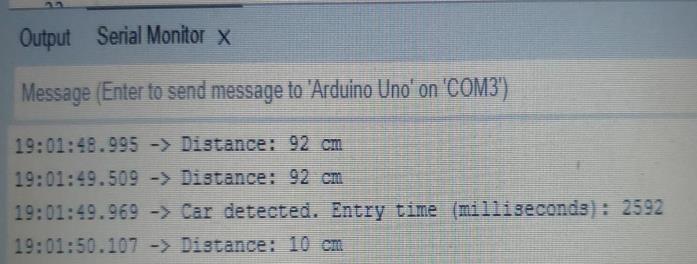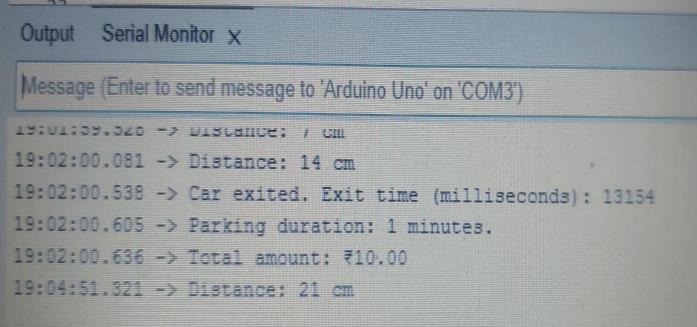
International Research Journal of Engineering and Technology (IRJET) e-ISSN:2395-0056
Volume: 11 Issue: 10 | Oct 2024 www.irjet.net p-ISSN:2395-0072


International Research Journal of Engineering and Technology (IRJET) e-ISSN:2395-0056
Volume: 11 Issue: 10 | Oct 2024 www.irjet.net p-ISSN:2395-0072
S. Sangamithra1, M. Sornalatha2, P.G. Soundharya Sri2 , R. Subhashini2
1 Assistant Professor, Department of Computer Science and Engineering, K.L.N. College of Engineering and Technology, Sivagangai, Tamil Nadu, India.
2 Student, Department of Computer Science Engineering, K.L.N. College of Engineering and Technology, Sivagangai, Tamil Nadu, India.
Abstract - A fully automated parking management system utilizing FASTag technology integrated with Orion RFID tags and ultrasonic sensors to streamline vehicle entry, parking duration monitoring, and payment processing. The system captures the FASTag UID from both entry and exit points using Orion RFID tags. Ultrasonic sensors monitor vehicle presence within the parking slot, enabling real-time detection of entry and exit times. A microcontroller stores these timestamps and calculates the duration of parking using a timediff algorithm. Upon exit, the microcontroller verifies the FASTag UID at both entry and exit points. It processes the corresponding payment by transmitting the calculated parking fee to the vehicle owner’s bank account linked to the FASTag system. The system ensures a seamless and automated transaction, with payment confirmation sent via standard bank notification methods. This project enhances parking efficiency, reduces human intervention, and facilitates secure, automated transactions.
Key Words: Automated parking, FASTag, RFID tags, Ultrasonic Sensor, Microcontroller, Vehicle Detection, ParkingDuration,Paymentprocess.
Automatingparkingmanagementsystemshasbecome essential in modern urban environments to enhance efficiency and reduce manual intervention. Utilizing FASTag technology integrated with Orion RFID tags and ultrasonic sensors, this project presents a streamlined solution for capturing vehicle information, monitoring parking duration, and processing payments. At the entrance of the parking area, Orion RFID tags scan and capture the FASTag UID, storing it in a microcontroller. Once the vehicle reaches the parking slot, ultrasonic sensors detect the vehicle’s presence and trigger a timestamp to capture the entry time. Similarly, when the vehicle exits the slot, the system detects the change, records the exit time with another timestamp, and stores bothtimesinthemicrocontroller.Theparkingdurationis then calculated using a timediff algorithm. Upon exiting, theFASTagUIDisverifiedattheexitpoint,andthesystem processes the payment by sending the calculated amount tothelinkedbankaccount.Thisapproachensuresefficient
real-time tracking, secure data handling, and seamless automatedtransactions.
FASTag technology combined with Orion RFID tags allows for efficient, automated vehicle identification and entry. As vehicles approach the parking area, the RFID system automatically scans the FASTag UID, eliminating manual processes and reducing wait times. This not only minimizeshumanerrorbutalsostreamlinestrafficflowat parking entrances. The system’s ability to capture the tag from a distance enables smooth entry, improving overall userconvenienceandoperationalefficiency.
Ultrasonic sensors are used to accurately monitor the presence of a vehicle in the parking lot. These sensors detect the vehicle's entry and exit, allowing the system to calculate the total parking time. Upon exiting, the system automatically debits the parking fee from the linked FASTag account. This fully automated process ensures secure transactions and eliminates the need for manual payments, enhancing convenience for drivers while improvingoverallparkingmanagement.
ASmartparkingmanagementsystemthatintegratesRFID and sensor technology to automate entry, parking durationtracking,andpaymentprocessing


Volume: 11 Issue: 10 | Oct 2024 www.irjet.net p-ISSN:2395-0072
The Above figure focuses on an automated parking fee collectionsystemthatusesRFIDandultrasonicsensorsto track vehicles, calculate parking durations, and debit fees automatically.Thearchitecturereliesoncapturingvehicle entry and exit times using ultrasonic sensors and FASTag UID through Orion RFID tags. This data is processed by a microcontroller, which calculates the parking duration and initiates the payment process via linked bank accounts.
The Orion RFID tag scans the FASTag UID attached to the vehicle. This process begins when the car arrives at the parking area. The RFID system captures the unique identification of the car’s FASTag and sends this information to the microcontroller. The microcontroller then stores the FASTag UID, which will be essential for furtherprocessing.
2.
Once the vehicle reaches the parking slot, an ultrasonic sensor detects its presence by measuring the distance to the car. A predefined threshold value helps the system identify the car’s arrival. When the vehicle crosses this threshold, the microcontroller captures the entry time using a timestamp. This data is stored in the microcontroller, which plays a vital role in tracking the parkingduration.
When the vehicle leaves the parking slot, the ultrasonic sensor detects the exit by noticing the threshold value change. The microcontroller captures the exit time using anothertimestamp. To calculatethe total timethevehicle was parked, the system uses the Timediff algorithm. The duration of the parking session is stored, allowing the microcontrollertodeterminetheapplicableparkingfee.
● Inputs: It takes two time points (Start Time TI andEndTimeT2)
● Calculation: The difference is found using the formula:Timedifference=T2-TI
● Output: Theresultcanbeinminutes.
As the car approaches the exit, the Orion RFID tag scans theFASTagUIDonceagain.Themicrocontrollercompares this UID with the one captured during entry. This matching ensures that the correct car is being processed forpayment,avoidingerrorsinbilling.
Aftercalculatingtheparkingduration,themicrocontroller determines the fee to be debited from the linked FASTag account. It sends the required information, including the FASTag UID and the amount, to the bank. The bank processes the transaction, and the car owner receives a notification regarding the fee deduction, completing the automatedparkingsystem.
The automated parking system uses Orion RFID tags and ultrasonic sensors to capture a vehicle’s FASTag UID and detectits entryand exittimes.Themicrocontrollerstores theFASTagUIDandcalculatestheparkingduration using timestamps. At the exit, the RFID tag scans the FASTag again to verify the vehicle, and the microcontroller calculates the parking fee. The fee is then automatically debited from the vehicle owner’s FASTag-linked bank account, completing the process billed. After verification, themicrocontrollercalculatestheparkingfeebasedonthe duration and sends the necessary data (FASTag UID and fee) to the bank, where the amount is automatically debited from the vehicle owner’s linked FASTag account. The owner then receives a confirmation, completing the fully automated, human-free parking fee collection process.
● EntryFASTagUIDlog.
● Objectdetectionthroughsensor.
● Exittimechargecomputation.
● UIDauthenticationtransactionprocess.
The Entry FASTag UID Log module is a vital part of the parking management system, responsible for capturingandloggingtheFASTagUIDofvehiclesentering the facility. When a vehicle approaches, the Orion RFID reader activates, creating an electromagnetic field that

International Research Journal of Engineering and Technology (IRJET) e-ISSN:2395-0056
Volume: 11 Issue: 10 | Oct 2024 www.irjet.net p-ISSN:2395-0072
interacts with the FASTag attached to the vehicle. The FASTag responds by sending its unique UID to the reader inaninstantaneousprocess,allowingforseamlessvehicle identification without the need for manual intervention. This automated entry system improves the user experience, reducing congestion and speeding up vehicle entry.
Once the FASTag UID is scanned, it is transmitted to the microcontroller, which handles data collection and securely stores the UID for future reference. This secure logging of entry data is critical for tracking the vehicle's entrytimeand later calculating parking fees basedonthe duration of the stay. By linking the vehicle to its parking session, the system ensures accurateandfair billingupon exit.

To enhance the effectiveness of the Entry FASTag UID Log module, car presence detection is integrated using ultrasonicsensors.Whena vehicleapproaches,thesensor detects its presence by measuring the distance to the vehicle and signals the microcontroller to log the entry time. This immediate detection is crucial for calculating parking fees based on the duration of the vehicle's stay. The system ensures only properly positioned vehicles are detected by setting a specific threshold distance, minimizingfalsereadings.
Once the vehicle is detected, the system continuously monitors itsstatus, ensuringit remains parked. When the vehicle leaves, the sensor continuously reads the distance tochecktheothercartopresent.
Todetectthecarpresence
Emitting Sound Waves:
● The sensor consists of two main parts: the transmitter (emits high-frequency sound waves) and the
receiver (capturestheecho ofthesoundwaves bouncing backafterhittinganobject).
● Thetransmittersendsoutultrasonicsoundwaves at a frequency higher than humans can hear (typically around40kHz).
Echo Return:
● When the sound waves hit an object (e.g., a car), they reflect back towards the sensor. The sensor then measures the time it takes for the echo to return to the receiver.
Distance Calculation:
● Thedistancetothevehicleiscalculatedusingthe time taken for the sound wave to travel to the object and back, along with the known speed of sound in air (~343 meterspersecondatroomtemperature).
● `Theformulatocomputethedistanceis:
Distance=Time×SpeedofSound/2
The division by 2 accounts for the sound traveling to the vehicleandthenbacktothesensor.

In the parking management system,theExit Timeand Charge Calculation module ensures accurate tracking of vehicle departures and parking fees. Ultrasonic sensors monitor the distance to detect when a vehicle leaves its parking slot. Once the vehicle exits the threshold range, the system logs the exit time and retrieves the stored entry time. The parking duration is calculated by subtracting the entry time from the exit time, ensuring precisebillingbasedontheexactdurationofthestay.

Volume: 11 Issue: 10 | Oct 2024 www.irjet.net p-ISSN:2395-0072
The system is pre-programmed with a rate structure to computethefee.For example,iftherateis10per minute andthecarwasparkedfor1minute,thefeewouldbe10 rupees. Automated processing ensures real-time logging, accurate calculations, and fair pricing. Once the fee is determined, it is logged and linked to the user’s FASTag account for seamless debit during the final transaction. The automated system ensures consistency, minimizes errors,andfacilitatesauditingforaccuraterecord-keeping andrevenuemanagement.
The TIMEDIFF algorithm plays a crucial role in parking management systems by calculating the exact parking duration,whichisthenusedforfeecalculation. Similar to howanultrasonicsensorisusedforvehicledetection,the TIMEDIFFfunctionoperatesatthedatalevel,determining thetimedifferencebetweenavehicle'sentryandexit.
The primary function of the TIMEDIFF algorithm is to compute the difference between two time points: the entry time and the exit time. This difference represents how long the vehicle was parked and is critical for calculating parking fees, especially in systems where fees arebasedonthedurationofstay.
Thealgorithmrequirestwospecificdatapoints:
● Entry Time: The timestamp when the vehicle enters the parking facility, logged when the vehicle is detectedbyanultrasonicsensor.
● Exit Time: The timestamp when the vehicle exits the parking facility, triggered by either an ultrasonic sensorwhenthevehicleapproachestheexit.
The algorithm calculates the difference between the two timestampsusingthefollowingformula:
ParkingDuration=ExitTime−EntryTime
This calculation is performed at the level of seconds, minutes, hours, and even days if necessary. The result provides an exact duration, which can then be converted intoausableformatsuchastotalminutesorhours.

Fig: captureexittimeandcalculateparking duration andamountcalculation
The Exit Authentication and Payment Processing moduleisacriticalcomponentoftheparkingmanagement system, ensuring secure and efficient verification of vehicles leaving the parking area and automatically charging the correct fees. This module utilizes RFID technologytoauthenticatevehiclesattheexitandinitiates thepaymentprocessbasedonthecalculatedparkingfee.
As the vehicle approaches the exit point, the Orion RFID reader is activated. It emits radio waves to scan the FASTag attached to the vehicle’s windshield. The FASTag contains a unique identifier (UID) that was logged during the vehicle’s entry. Upon scanning the FASTag at the exit, the system retrieves the UID and compares it with the entry data.This process ensures the vehicleleavingis the sameonethatentered,preventingunauthorizedexitsand enhancingsecurity.
By matching the entry and exit UIDs, the system verifies the vehicle’s authenticity and ensures accurate fee calculation. This automated process eliminates potential errorsthatcouldarisefrommanualchecksormismatches in vehicle identification. The RFID-based system also offersaseamlessuserexperience,allowingvehiclestoexit quickly without the need for manual intervention, significantlyreducingdelays.
Once the exit is authenticated, the system retrieves the pre-calculatedparkingfee,whichisbasedontheduration ofthevehicle’sstay.Thefeestructureispre-programmed according to the parking facility's rate policy. After the parking fee is determined, the system initiates an automatic payment process by debiting the appropriate amount from the user’s FASTag account. This cashless transaction enhances convenience and speeds up the exit process.

International Research Journal of Engineering and Technology (IRJET) e-ISSN:2395-0056
Volume: 11 Issue: 10 | Oct 2024 www.irjet.net p-ISSN:2395-0072
The system logs all relevant information, including the vehicle’s FASTag UID, entry and exit times, parking duration, and calculated fee, for auditing and recordkeeping purposes. This automated logging ensures consistency and accuracy across all transactions, while alsoprovidinga reliablemethodforauditingandrevenue management. By eliminating human intervention, the system reduces errors, enhances transparency, and providesamoreefficientparkingmanagementexperience.

UIDauthenticationandpaymentprocess.
The integration of Orion RFID tags into the parking management system allows for the automatic identification of vehicles by reading their FASTag UIDs at both entry and exit points. This ensures that vehicles are accurately tracked throughout their stay in the parking facility. By using RFID technology, the system eliminates human error, providing a seamless and reliable process where vehicle data is captured and stored in real time. Additionally, ultrasonic sensors are used to log entry and exit times automatically. These sensors detect when a vehicle arrives or departs from a parking spot, ensuring precise tracking of parking duration without the need for manual input. This automation improves efficiency and reduces delays, enabling the system to calculate parking feesaccurately.
TheTimediffalgorithmplaysacrucialroleindetermining parking fees by calculating the difference between the entryandexittimes.Thisensuresthatcustomersareonly charged for the exact time their vehicle is parked, promoting fairness and transparency in fee assessments. BylinkingFASTagUIDstovehicleowners'bank accounts, the system facilitates automatic fee deduction, removing the need for manual payments. This streamlines the payment process, making it faster and more secure by eliminatingcashorcardtransactions.
Overall, this automated parking management system is user-friendly, scalable, and adaptable to various parking environments. It reduces operational costs by minimizing human intervention and errors, while providing a transparent, efficient, and secure solution for both users andfacilityoperators.
[1] AlessandroFloris,SimonePorcu,LuigiAtzori,and Roberto Girau, "A Social IoT-based platform for the deployment of a smart parking solution”, Computer Networks,vol.205,pp.108756,2022.
[2] Fadi Al‐Turjman, Hadi Zahmatkesh, and Ramiz Shahroze, “An overview of security and privacy in smart cities IoT communications, ”Transactions on Emerging Telecommunications Technologies, vol. 33, no. 3, pp. e3677,2022.
[3] Khanna, A., Anand, R. (2021). IoT-based Smart Parking System Using FASTag. IEEE Xplore. This article outlines a smart parking solution using IoT with an emphasisonFASTagforautomaticpaymentsystems.
[4] Sadhukhan, P. (2021). Real-time Smart Parking System Using IoT. Springer. Focuses on real-time parking slotdetectionandoccupancy.